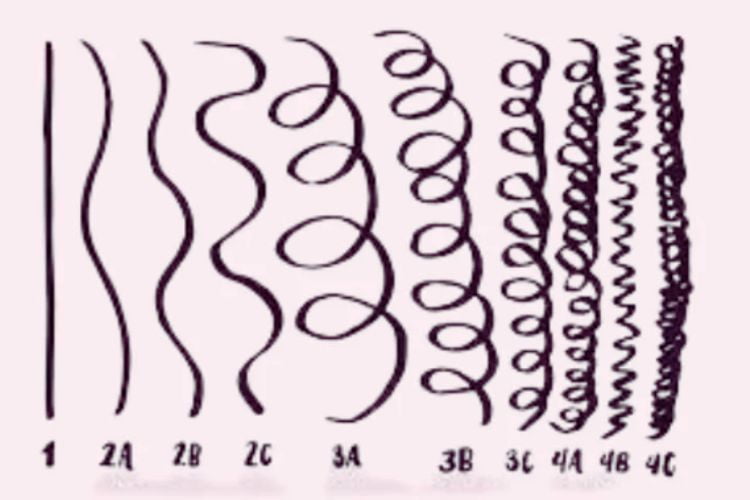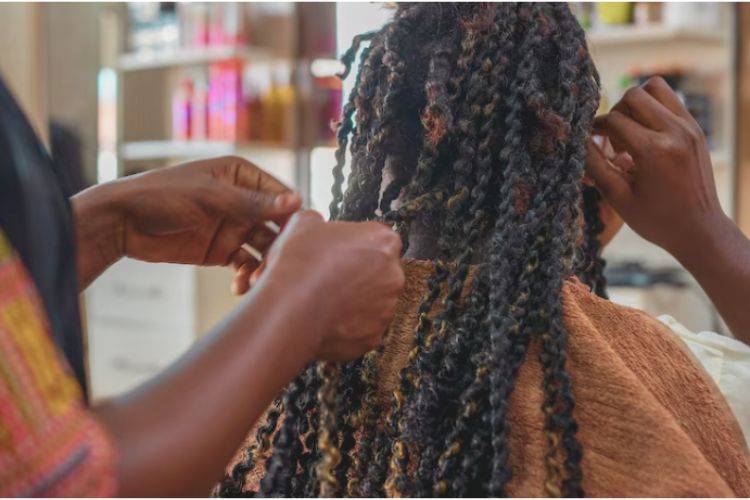Embracing your natural hair is not only a journey of self-discovery but also a celebration of your unique identity. By accepting and nurturing your curls, you promote a healthier hair and scalp environment while simultaneously breaking free from the societal pressures and norms that often encourage the alteration of one’s natural hair texture.
The decision to transition to curly hair can be life-changing, empowering you to redefine beauty on your own terms and fostering a deep sense of self-love and acceptance. The transitioning to curly hair process involves gradually growing out your natural hair and phasing out chemical treatments or heat styling tools that can damage your curls.
This journey requires patience, dedication, and a tailored hair care routine that caters to your specific curl type. Along the way, you’ll learn to appreciate the versatility and unique beauty of your curls, as well as the freedom that comes with embracing your true, authentic self.
I. Understanding Your Curl Type

A. Different Curl Patterns
Transitioning to curly hair encompasses a diverse range of textures and curl patterns, each with its own unique characteristics and beauty. The most common classification system, developed by hairstylist Andre Walker, includes four main hair types, with Type 3 and Type 4 being curly and coily, respectively.
Type 3 hair is typically characterized by S-shaped curls, ranging from loose (3A) to tight (3C) curls. 3A curls are large, loose spirals, while 3B curls are more defined, bouncy ringlets, and 3C curls have tighter, corkscrew-like coils.
Type 4 hair, on the other hand, features tightly coiled or zigzag patterns, with 4A hair having tight coils, 4B hair consisting of Z-shaped strands, and 4C hair being the most densely packed with a nearly indistinguishable curl pattern.
Understanding your specific curl pattern is essential for determining the best hair care practices and products to maintain the health and appearance of your curls. It’s important to note that an individual’s head of hair may comprise a mix of different curl patterns, adding to the distinctive beauty of their natural hair.

B. Hair Strand Type and Density
Knowing your hair strand type and density is crucial for developing a personalized hair care routine that caters to your unique needs. Hair strand type refers to the thickness of individual hair strands, which can be classified as fine, medium, or coarse. Fine hair is delicate and prone to breakage, while coarse hair is thicker and more resistant to damage.
Medium hair falls in between these two categories. To determine your strand type, simply take a single hair strand and roll it between your fingers. If it’s barely noticeable, it’s likely fine; if it feels thick or textured, it’s coarse; and if it’s somewhere in between, it’s medium.
Hair density, on the other hand, pertains to the number of hair strands per square inch on your scalp. Hair can be classified as low, medium, or high density. To assess your hair density, allow your hair to air-dry without any styling products, then examine your scalp in a mirror.
If you can easily see your scalp without moving your hair, you have low-density hair. If you can’t see your scalp at all, you have high-density hair. And if you can see some of your scalp but not all of it, your hair has medium density.
Understanding your hair strand type and density is essential for selecting the right products, techniques, and styles to maintain the health and appearance of your curls. For instance, fine hair may benefit from lighter products to prevent being weighed down, while coarse hair may require heavier, more moisturizing products.
Similarly, low-density hair may need volume-enhancing techniques, while high-density hair may require more strategic layering and detangling methods. By considering both your curl pattern and these two important factors, you can create a tailored hair care routine that allows your natural curls to thrive.
Hair porosity.
Hair porosity is a critical aspect of hair health, as it determines how well your hair can absorb and retain moisture. Porosity levels can be categorized as low, medium, or high, with each level requiring specific care to maintain optimal hydration. Low porosity hair has tightly sealed cuticles, making it difficult for moisture to penetrate the hair shaft.
High porosity hair, on the other hand, has raised or damaged cuticles, which allow moisture to enter the hair shaft easily but also escape quickly. Medium porosity hair strikes a balance between the two, absorbing and retaining moisture effectively.
Understanding your hair’s porosity is essential for selecting the appropriate products and techniques to maintain healthy, moisturized curls. Low porosity hair may require heat or lighter, water-based products to open up the cuticles and facilitate moisture absorption, while high porosity hair may benefit from protein treatments, heavier creams, and sealants to help retain moisture and repair damaged cuticles.
By catering to your hair’s unique porosity level, you can ensure that your curls remain well-hydrated and resilient throughout your transitioning to curly hair journey. Read about how to identify your hair porosity on our detailed post here.
II. Preparing For The Transition

A. Setting Realistic Expectations
Setting realistic expectations for your transitioning to curly hair journey is essential for maintaining motivation and ensuring a positive experience. It’s important to understand that transitioning to curly hair is a gradual process that requires patience, dedication, and consistent care.
Hair growth rates vary among individuals, and it might take several months or even years to achieve your desired length and fullness. Moreover, as you transition, you may encounter various challenges, such as dealing with multiple textures or managing breakage, which will require time, effort, and adjustments to your hair care routine.
While transitioning to curly hair, it’s crucial to avoid comparing your hair journey to others’, as every individual’s hair is unique, and progress will differ based on factors like genetics, lifestyle, and hair care practices. Instead, focus on learning about and embracing the distinct characteristics of your own hair, experimenting with different products and techniques to discover what works best for you.
Document your progress through photos, journaling, or even sharing your journey on social media, celebrating milestones and appreciating the positive changes in your hair’s health and appearance.
By setting realistic expectations, you can approach your transitioning to curly hair journey with a growth mindset, embracing the challenges and learning opportunities that come with embracing your natural curls. This mindset will not only help you stay committed to your hair care routine but also foster a deeper sense of self-love and appreciation for the unique beauty of your natural hair.
B. Establishing a transitioning to curly hair Timeline

Establishing a transitioning timeline is an important step in your hair transitioning to curly hair journey, as it helps you set goals, track progress, and maintain focus. Your timeline should take into account factors such as your starting hair length, desired length, and personal preferences regarding the pace of transitioning to curly hair.
Some individuals may prefer a gradual transition, slowly trimming off chemically treated or heat-damaged hair as their natural curls grow, while others may opt for the “big chop,” cutting off a significant portion of their hair to start afresh with their natural texture.
When creating your timeline, consider setting short-term and long-term goals, such as reaching a specific length, attaining a certain level of hair health, or mastering a new styling technique. These milestones can provide motivation and a sense of accomplishment as you progress on your journey.
Additionally, it’s essential to remain flexible with your timeline, as hair growth rates and transitioning to curly hair challenges may vary from person to person. Be prepared to adjust your goals and expectations as needed, and remember that patience and consistency are key components of a successful journey for transitioning to curly hair.
By establishing a transitioning to curly hair timeline, you can approach your journey with a sense of direction and purpose, helping you stay committed to nurturing your natural curls and achieving the hair health and appearance you desire.
C. Finding Inspiration and Support
Finding inspiration and support during your transition journey is vital for staying motivated and maintaining a positive mindset. Surrounding yourself with people who understand and encourage your decision to embrace your natural curls can make a significant difference in your overall experience.
Friends and family members who have gone through similar journeys can provide valuable insights, tips, and empathy. Additionally, seeking inspiration from others who have successfully transitioned can help you visualize your end goal and stay focused on your journey.
In today’s digital age, online communities and social media platforms offer a wealth of resources for connecting with like-minded individuals and finding inspiration. Joining forums,
Facebook groups, or following influencers and hashtags related transitioning to curly hair can introduce you to a diverse range of experiences, stories, and advice from people at different stages of their transitioning to curly hair journey.
These virtual connections can provide the encouragement and camaraderie needed to navigate the challenges and celebrate the triumphs that come with embracing your natural hair.
By finding inspiration and support, you create a nurturing environment that fosters self-love, resilience, and a sense of belonging. This support network will not only help you stay committed to your hair care routine but also enable you to appreciate the unique beauty of your natural curls and share your own experiences to inspire others in their journey.
III. Building a Curly Hair Care Routine

A. Washing and Conditioning
i. Choosing the right products
When transitioning to curly hair, selecting the appropriate products for washing and conditioning is crucial for promoting hair health and enhancing your curl definition. Look for sulfate-free shampoos, as sulfates can strip your hair of natural oils and lead to dryness (you can use a clarifying shampoo once a month to speed your transitioning to curly hair process) .
Opt for moisturizing conditioners and deep conditioning treatments that are specifically designed for transitioning to curly hair, as they help nourish and hydrate your curls while reducing the risk of breakage.
ii. Techniques for washing and conditioning curly hair
Adopting proper techniques for washing and conditioning your curls is essential for maintaining their health and appearance. When washing, focus on massaging the shampoo onto your scalp, allowing the water and lather to cleanse the rest of your hair as you rinse.
For conditioning, apply the product to the mid-lengths and ends of your hair, using your fingers or a wide-tooth comb to distribute it evenly. Be sure to rinse with cool water to seal the hair cuticles and lock in moisture. Additionally, consider incorporating a weekly deep conditioning treatment into your routine to provide extra hydration and nourishment to your transitioning to curly hairs.
B. Detangling and Styling
i. Tools and methods for detangling
Curly hair is prone to tangles and knots, making proper detangling techniques a critical aspect of your hair care routine. Use a wide-tooth comb or a specialized detangling brush, and always detangle your hair when it’s wet and coated with conditioner to minimize breakage.
Work from the ends of your hair towards the roots, gently removing knots and tangles without causing unnecessary stress to your hair strands.
ii. Styling tips for different curl types
Different curl types require unique styling techniques to enhance their natural beauty. For looser curls, scrunching your hair with a microfiber towel or cotton T-shirt can help define your curls and reduce frizz. For tighter curls and coils, consider using the shingling or finger-coiling method to separate and define individual curls.
Regardless of your curl type, it’s crucial to avoid heat-styling tools and instead opt for heatless methods, like twist-outs or braid-outs, to maintain the health and integrity of your transitioning to curly hair.
C. Maintaining Moisture and Reducing Frizz
i. Importance of hydration
Hydration is essential for maintaining the health and appearance of your curls, as well-moisturized hair is more resistant to breakage and frizz. Curly hair tends to be naturally drier than straight hair, so providing extra hydration through products and techniques is crucial for a successful transitioning to curly hair journey.
ii. Products and techniques to maintain moisture
To maintain moisture in your curls, incorporate leave-in conditioners, creams, or oils into your routine. Layering these products using the LCO (liquid, cream, oil) or LOC (liquid, oil, cream) method can help lock in moisture and nourish your hair throughout the day. Additionally, consider using a humidifier or incorporating a regular steam treatment to provide extra hydration to your transitioning to curly hair.
D. Nighttime Hair Care Routine
A. Protecting Your Curls While You Sleep
i. Protecting your curls while you sleep
Preserving your curls overnight is key to maintaining their health and appearance. Use a silk or satin pillowcase to minimize friction and prevent breakage, or wrap your hair in a silk or satin bonnet or scarf to protect your curls from damage and frizz.
ii. Refreshing your curls in the morning
Upon waking, your curls may need some refreshing to restore their bounce and definition. Use a water and leave-in conditioner mixture in a spray bottle to rehydrate your hair, and then gently scrunch or finger-coil your curls as needed. This simple morning routine can help revive your curls and maintain their health
IV. Dealing With The “In-Between” Phase

A. Managing Multiple Textures
During the transition phase, you may find yourself dealing with multiple textures as your natural curls grow in alongside your chemically treated or heat-damaged hair. This can present unique challenges, as each texture requires different care and maintenance.
To manage multiple textures, ensure that you’re using products that cater to both your natural curls and the treated hair, keeping them well-moisturized and nourished. Regular deep conditioning treatments and protein treatments can also help maintain the overall health and strength of your hair during this stage.
B. Hairstyles to Help During The Transition
Experimenting with protective and low-manipulation hairstyles can help you navigate the “in-between” phase more easily. These styles not only reduce the stress on your hair but also allow you to blend the different textures seamlessly. Some popular options include braids, twists, bantu knots, and updos like buns or flat twists.
Wigs and hair extensions can also provide temporary solutions for styling your hair while you wait for your natural curls to grow. Be sure to change your protective styles regularly and maintain a consistent hair care routine to ensure that your hair remains healthy during the transition.
C. Deciding on a “Big Chop” or Gradual Trimming
One critical decision you’ll need to make during your transition journey is whether to opt for a “big chop” or gradually trim your treated hair. The “big chop” involves cutting off a significant portion of your hair to remove the damaged ends and start fresh with your natural curls.
This option can be liberating and allow you to fully embrace your natural texture more quickly. However, it might not be the ideal choice for everyone, especially those who are uncomfortable with shorter hair lengths. Gradual trimming involves slowly cutting off the treated hair over time as your natural curls grow in, allowing you to maintain a longer length during the transition.
This method requires more patience and consistent care but can be less dramatic and more manageable for some individuals. Ultimately, the decision between the “big chop” or gradual trimming depends on your personal preferences and comfort levels.
V. Embracing Your Natural Hair Journey

A. Celebrating Milestones and Progress
As you embark on your natural hair journey, it’s essential to acknowledge and celebrate milestones and progress along the way. Whether it’s reaching a specific hair length, noticing an improvement in your hair’s health, or mastering a new styling technique, these achievements can provide motivation and a sense of accomplishment.
By documenting your journey through photos, journaling, or sharing your experiences on social media, you can reflect on your progress and appreciate the positive changes in your hair’s health and appearance.
B. Troubleshooting Common Issues
During your transition journey, you may encounter various challenges, such as breakage, dryness, or frizz. Troubleshooting these common issues is an integral part of embracing your natural hair journey, as it helps you develop resilience and adaptability.
When faced with a problem, research potential solutions and experiment with different products, techniques, or lifestyle changes to address the issue.
Connecting with others who have faced similar challenges and seeking their advice can also provide valuable insights and support. Remember that setbacks are a natural part of any journey, and learning from them can ultimately lead to a more successful and enjoyable transition.
C. Adjusting Your Routine as Your Hair Changes
As your hair transitions to its natural state, you may need to adjust your hair care routine to accommodate the evolving needs of your curls. Factors such as hair growth, changes in curl pattern, or even external conditions like weather or humidity can impact your hair’s health and appearance.
Regularly evaluate your routine and make any necessary adjustments to ensure that you’re providing optimal care for your hair at every stage of your journey. By remaining flexible and adaptive, you can continue to nurture and celebrate the unique beauty of your natural curls.
Conclusion For Transitioning to Curly Hair
In conclusion, transitioning to curly hair is a transformative journey that extends beyond mere aesthetics—it’s an empowering process that fosters self-acceptance, resilience, and self-love.
By understanding the unique characteristics of your hair, setting realistic expectations, and building a tailored hair care routine, you can successfully navigate the challenges and triumphs of embracing your natural curls. Remember to seek inspiration and support from others, celebrate milestones, and continuously adapt your routine as your hair evolves.
As you embark on this journey, cherish the opportunity to reconnect with your authentic self and proudly showcase the beautiful, unique curls that are inherently yours. At Naturiam, you will find everything you need for a smooth and successful transitioning to curly hair.



